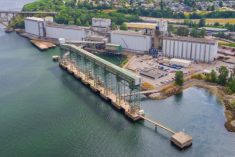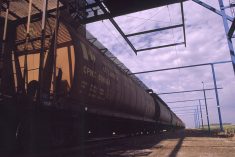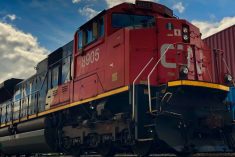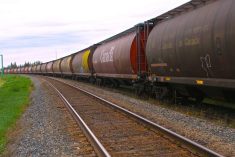Coming off a record-level Prairie grain handle, Canadian National Railway’s $1.042 billion in 2020-21 Prairie grain revenue is set to be trimmed by about $2.52 million.
The Canadian Transportation Agency on Wednesday released its determination that CN’s 2021-21 Prairie grain revenue of $1,044,909,345 came in $2,399,676 above its maximum revenue entitlement (MRE) for the year.
CN’s rival Canadian Pacific Railway, meanwhile, booked 2020-21 Prairie grain revenue of $1,035.175,212, which put it $20,248,072 below its MRE for the crop year.
The CTA’s decision gives CN 30 days to pay out its overage — plus a five per cent penalty of $119,984 — to the Western Grains Research Foundation, the mandated beneficiary when either railway exceeds its annual revenue cap.
Read Also

Huge crops in South America says analyst
Although there’s a debate over the size of the South American soybean crop, there’s little doubt that it will be an enormous one, said consultant Michael Cordonnier of Soybean and Corn Advisor in Hinsdale, Ill.
The CTA noted the 2020–21 crop year was a record year for the railways in terms of combined Prairie grain handle at 52,334,795 tonnes of western grain — the “highest volume ever on the record” and nine per cent over the 2019-20 handle.
CN moved 26.36 million tonnes of Prairie grain during the crop year, the CTA said, while CP moved 25.98 million.
CN and CP recorded average weighted haul lengths of 1,018 and 913 miles respectively during the crop year — a combined average of 966 miles, up 0.1 per cent on the year.
Commonly called the “revenue cap,” the MRE for each of the two railways varies with the tonnage of grain moved. A railway company can keep within its MRE, the CTA said, “so long as it does not charge more, overall, than the average rate per tonne as set by the first part of the MRE formula.”
The MRE formula factors in the tonnage each railway hauls, the average length of haul and the volume-related composite price index (VRCPI), an inflation index set each year by April 30 to reflect each railway’s costs for labour, fuel, materials and capital purchases.
The VRCPIs for CN and CP for 2020-21 were first set in April last year at 1.4202 and 1.4205 respectively — both down from 2019-20. However, both were later increased as the two railways sought to get additional costs factored into the VRCPIs. Among those were:
- costs CN incurred obtaining hopper cars, as per 10 car supply agreements and three purchase agreements;
- CP’s cost of capital, after an April 9 ruling from the Federal Court of Appeal that the CTA should determine CP’s cost-of-capital rate for 2020-21 with the same methodology used for 2019-20; and
- CN’s decision to extend its lease by three months to the end of the 2020-21 crop year on a fleet of G3 hopper cars, rather than return them at the end of April 2021 as originally planned, “given notable grain volume increases this crop year.”
The final VRCPIs used to set the MREs for CN and CP for 2020-21 were 1.4441 and 1.5055 respectively. — Glacier FarmMedia Network
















